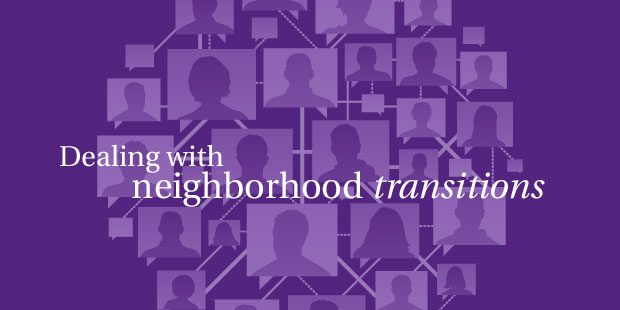
Dealing with Neighborhood Transitions in Your Church, Part 1
Donald McGavran was a third generation missionary child in India and later a professor at Fuller Theological Seminary. His unique background provided first-hand observations of both the Indian caste system and mid-twentieth century America, including the rise of suburbia and the perceived superiority of certain classes. Consequently, McGavran became particularly concerned with understanding and overcoming social barriers he saw as preventing people from coming to Christ.
In 1970, McGavran wrote a Church Growth text entitled Understanding Church Growth, in which he presents a somewhat controversial thesis known as the Homogeneous Unit Principle. He purports that people more readily choose to become Christians when they do not have to cross racial, linguistic, or class barriers.
Instead, he explained that people tend to be drawn to a homogeneous unit, a broadly defined term explaining people who share common characteristics. Shared characteristics can include geographical location, political views, ethnic backgrounds, or social class, thus instigating the controversy. Though McGavran was far from a racist, many have viewed his thesis as racist. This is unfortunate because I have to agree with the central premise of McGavran’s thesis– it is an observable fact that people are more often reached in homogenous relationships. Whether that is a GOOD thing is not the same thing as denying it is a TRUE thing.
It’s no great secret that a Korean is more likely to hear the gospel and respond by grace through faith in a Korean church rather than a Haitian church. This is not rocket science. However, the issue arises in light of the massive amounts of change and transition occurring among America’s people and landscape. How do we address these issues when an Anglo neighborhood becomes predominantly African-American or when an African-American neighborhood transitions to a Korean one? How should we think about neighborhood transition in regards to culture and homogeneity (most churches that are transitioning are homogenous)?
On March 31, 2011, The Congressional Research Service published a report, “The Changing Demographic Profile of the United States,” that concludes that the U.S. is getting bigger, older, and more diverse. For example, based on census data and recent research, the report projects that by 2050, the Asian population alone will increase by nearly 220 percent. It also projects that Hispanic Americans will make up just over 30 percent of the population by 2050.
Clearly, this has some implications on both the rapidly changing landscape of our towns and cities and the local church’s role in the midst of transition. When discussing the issue hypothetically or as an outside observer, one can easily say “Here’s what we should do.” For those who have gone through or are currently going through such a transition, however, knowing the best way to respond proves a great challenge due to the multiple factors at work.
As I see it, there are three primary options:
- congregational relocation to a context more in line with their congregation,
- intentional multicultural integration in one congregation, or
- multi-congregational partnership in one building.
I’ll be exploring those options in the next few weeks.
For part 2 of this series, click here.
Read more from Ed here.

Tags: Community Demographics, Ed Stetzer, Kingdom Concept, Local Predicament, Neighborhood Transitions













